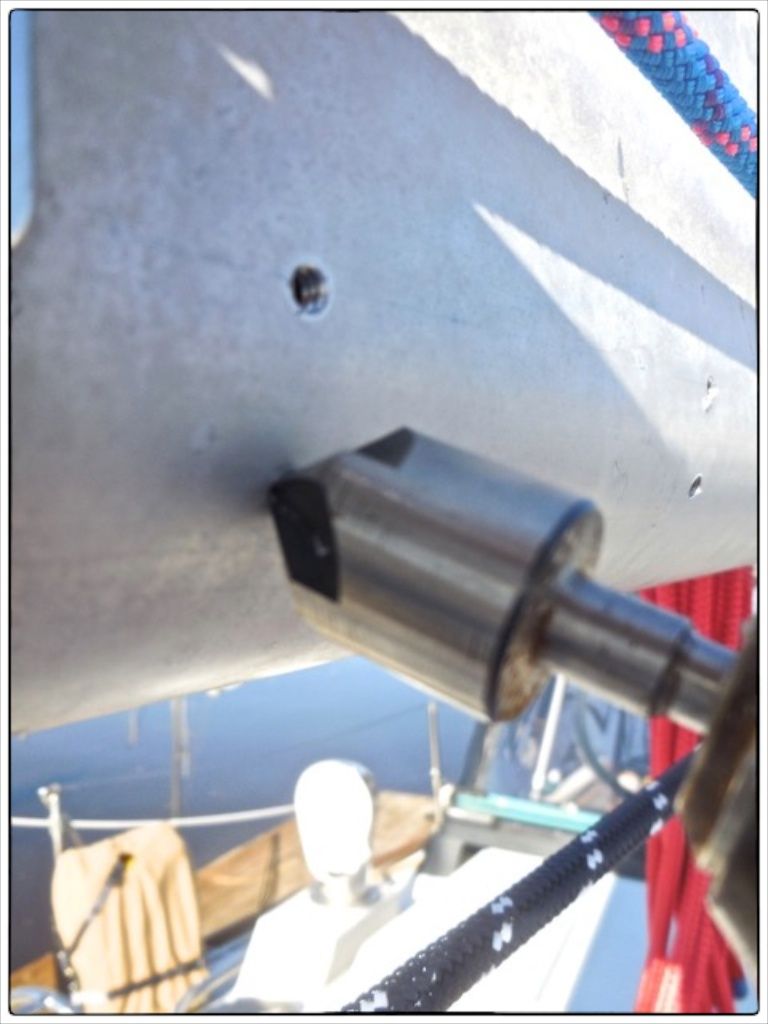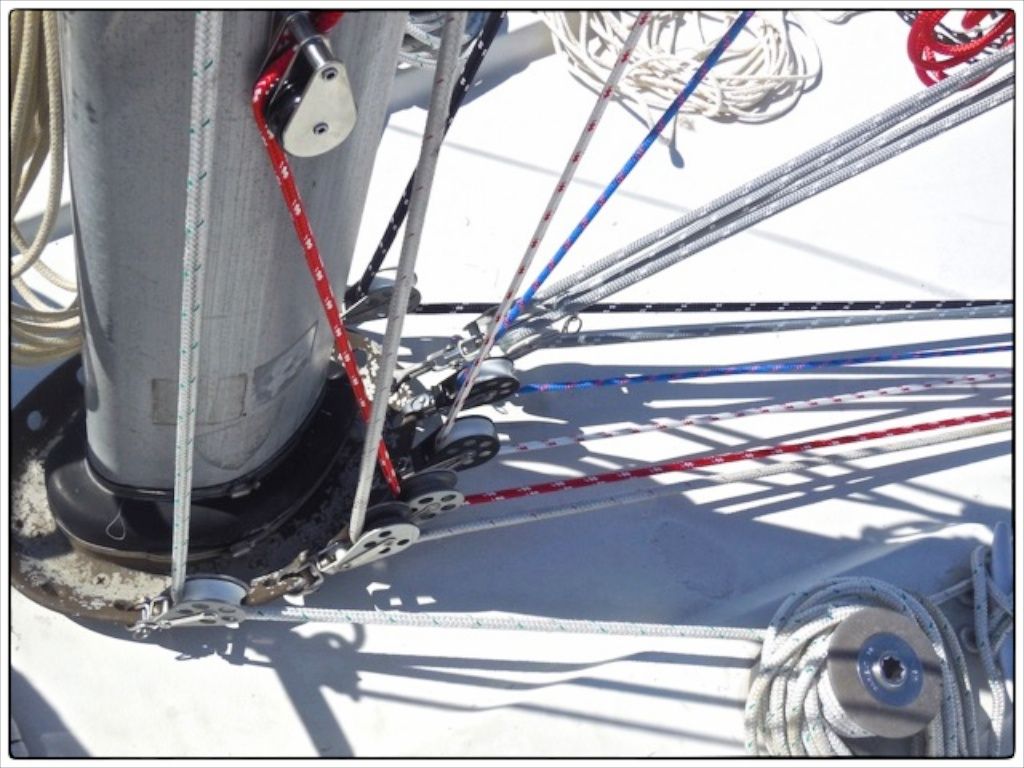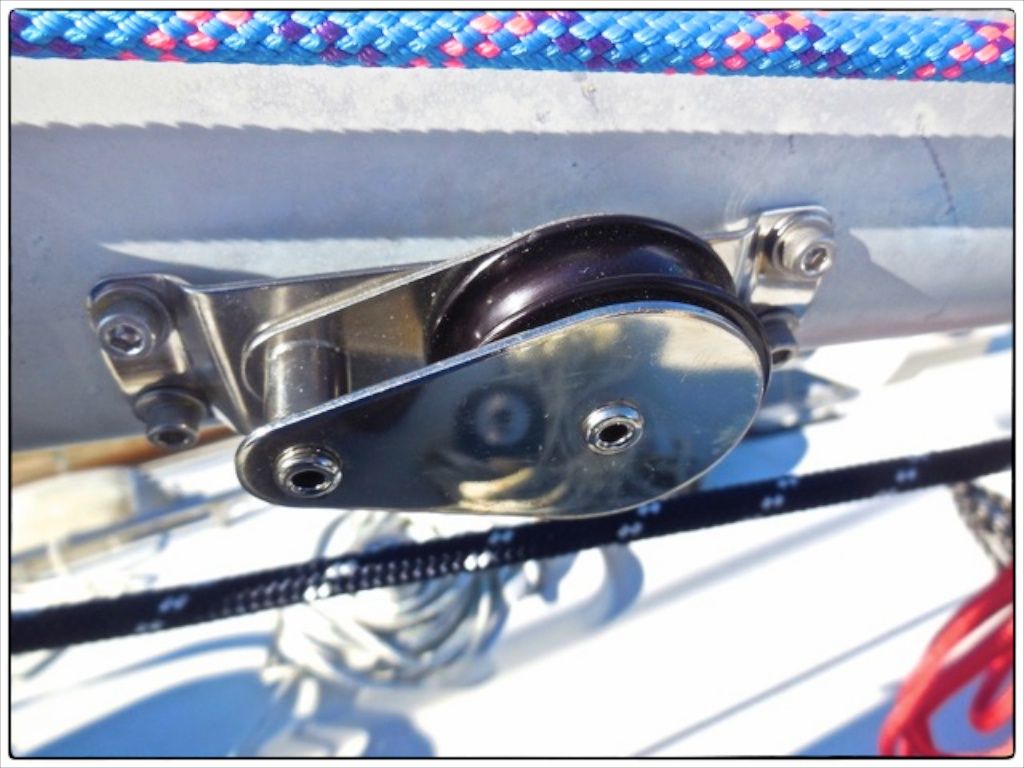Leading Lines Aft - Part 4
--Blogpost written by Bob
This is the fourth blogpost in our series for leading lines aft. It covers our new topping lift, and two new mainsail reefing lines.
New Topping Lift
The topping lift carries the weight of the boom when the mainsail is not in use, otherwise it would simply drop onto the hard dodger. The topping lift is also used in preparation for reefing the mainsail--this is the reason that we are leading this line aft to the cockpit. (Some sailboats use a rigid vang or boom kicker for this purpose.)
The topping lift is a relatively small diameter line, compared to the main sheet and boom vang. While shopping at Annapolis Performance Sailing, I found a really cool 5/16-inch diameter line, Marlow Excel Pro, in blue. It's not just blue--it's electric blue with flecks of pink and purple! It has a polyester core and polyester cover. It is being discontinued and I got the last of the roll.
I purchased a blue ball stopper with the line. I intend to install the ball stopper on the topping lift at a point when the boom was at his lowest expected position (just clearing the hard dodger by a few inches--this way, the line can't be let go, allowing the boom to come crashing down. I will apply a yellow heat shrink band on the new topping lift (just clear of its rope clutch) when the boom is perfectly level and it is in its stored position.
I had to install an additional turning block on the boom near the gooseneck (where the boom connects to the mast) to properly direct the line to the sheave at the base of the mast. I purchased the Garhauer turning block at the Miami Boat Show.
After carefully laying out the bolt pattern on the boom, I use a punch to make a detent on the boom where the drill was to be centered. I drilled all four holes, first with a smaller pilot drill and then using the proper size tap drill for 10-24 threads. I hand tapped all four holes.
 |
| I usually steady the tap with my left hand while turing the handle with my right hand--this insures that the threads are made perpendicular to the surface being tapped. |
 |
| I usually de-burr the tapped holes using a countersink tool in a portable drill--this makes the entry of the cap screw easier and makes it look professional. |
New Mainsail Reefing
The purpose of mainsail reefing is to reduce the main sail's area when heavy winds are encountered. The sail area is reduced by pulling down on the sail and fastening the sail to the boom through each of two holes (called a cringle) for each reef point. A cringle is a hole in the sail that is reinforced with a large metal grommet to accommodate a rope passing through while minimizing abrasion on the sail material. The cringles for each reef point are located a few feet up from the bottom of the sail
The one reefing line that was always led aft only controlled the aft reef point of the mainsail--the forward reef point was always clipped to the "cow horns" on the boom and for this reason, someone (usually me) always had to go forward to the mast to reef the mainsail.
We only have space on the new deck organizer for running two reefing lines aft to the cockpit. Our new mainsail has two reef points. So, we decided to run both luff (forward) and leach (aft) reefing lines for only the first of the two reef points back to the cockpit since the second reef point is rarely used.
 |
| I marked the hole pattern for the new turning block on the mast and center punched the locations before drilling and tapping the holes for 10-24 threads. |
The forward reefing line attaches to a lug on the boom, comes through a cringle in the mainsail, and then leads to a new turning block on the mast--the reefing line via the locations of the lug and the new turning block on the mast exert a forward and downward pull on the mainsail.
 |
| The completely installed mast turning block for the forward mainsail reefing line is shown in the above photograph--the red line with white flecks. |
For the forward reefing line I used a red line with white flecks, while the aft reefing line is white with red flecks. Both lines are 3/8-inch polyester construction.
Summary
 |
| The new 6-sheave deck organizer is now full with six lines running aft to the cockpit. |
 |
| This view is from the cabin top and shows all six lines leading aft to the cockpit. |
Now, leading the lines aft has been pretty much completed. As part of this project, I will be replacing the mainsheet traveller lines and installing cockpit hangers for all the lines--this will be covered on the next and last blogpost of this series. My new mainsail will be installed early next week!
Thanks for following our blog!


No comments:
Post a Comment